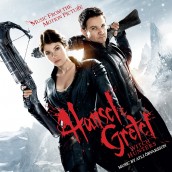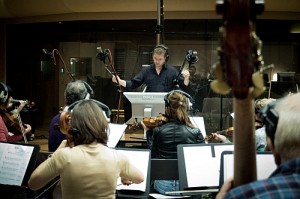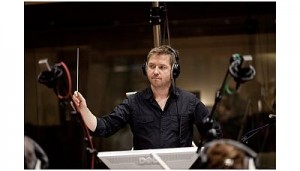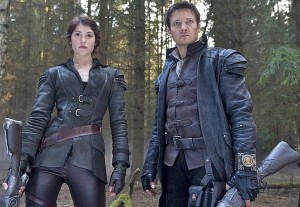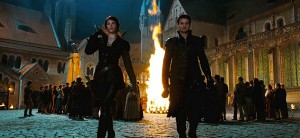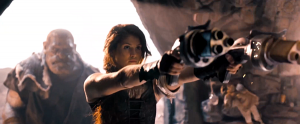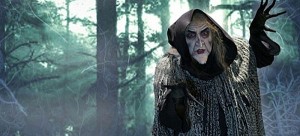More than ever, Hollywood is behaving like some hyperactive, post-hip kid tapping a pencil in history class or being put to bedtime, envisioning those usually boring world changers and fairy tale cherubs as pumped-up, sword-swinging, axe-hacking and shotgun-toting avengers who are anything but the stuff of their parents’ musty books. The result of these absurdist revisionisms have given film scores some memorable monster mashes, as heavy metal guitars, ripping electric percussion and blasting orchestras have jammed with the far more sedate fiddles of Abraham Lincoln’s prairie, or the daintily plucked harps of Lewis C. Carroll’s Victorian England.
Now it’s time for two famously cute little German kids to grow up into leather-clad hot messes, with an axe to grind (among several other crone-killing weapons) against the spell casters who caused them no end of childhood trauma in a gingerbread house. The calling cards of HANSEL AND GRETEL WITCH HUNTERS mean deadly serious business, even as the film by Norwegian director Tommy Wirkola is able to crack just a bit of a smile for the absurdist set-up, applying the same kind of kinetically ghoulish style he gave to the well-chilled Nazi zombies of DEAD SNOW, if with just a bit less grue here.
If Hansel’s got a busty bird of a feather, then the skewed Nordic humor of Wirkola is in very good company with his fellow frost-brother Atli Örvarsson. Hailing from the land of Ice where the temperatures tend to bring out the uniquely eccentric best from musicians weaned on way-darker fairy tales, Örvarsson has created a soundtrack that’s at once supernatural Mittle Europe as it is state of the action scoring art. It’s a deliriously exciting realm where the hacks, cackles and choruses of demented biddies rock over rhythmic adrenalin. A stern, memorably melodic theme is the call to witch-slaying, metal chord percussion, fairy tale bells and organs weaving dark enchantment as they slay with a satiric smile.
But while Örvarsson’s score might be the Brothers Grimm by way of Motorhead and Jason Bourne, the epic musical craftsmanship that’s gone into HANSEL AND GRETEL WITCH HUNTERS makes it no high-concept joke- as was the case with his far more straight-laced combo of ancient Celtic music and a 20th century orchestral beat for THE EAGLE‘s Roman adventure. Hailing from the Iceland hamlet of Akureyi, Örvarsson is one of the breakout musicians to heed the call of Team Zimmer in Santa Monica. Learning his blockbuster scoring craft with additional music for ANGELS & DEMONS, THE SIMPSONS MOVIE and PIRATES OF THE CARIBBEAN: AT WORLD’S END, Örvarsson flexed his own muscle in suspense, from the genre spectacles of BABYLON A.D. and THE FOURTH KIND to the political action arena of VANTAGE POINT and such TV shows as LAW & ORDER: LA and CHICAGO FIRE. But most recently it’s been skewed historical film that have brought out Örvarsson’s most intriguing work, whether it be THE EAGLE or his other, far more musically grim foray into hag-busting with SEASON OF THE WITCH. But perhaps no work of Örvarsson’s provides a wildly entertaining broom ride like HANSEL AND GRETEL WITCH HUNTERS a thrillingly stylistic score that shows that boring old fairy tale music can kick ass with stylistic energy that’s anything but snarky.
ASSIGNMENT X: How does one go from Iceland to Hollywood as a film composer?
Örvarsson: Well…. In my case, I found myself, at the age of 22 in a rock’n’roll band with gold and platinum records, having played classical music and jazz with some of the finest musicians in the country and decided that I needed a new challenge. So I went to Berklee College of Music, without really knowing what I was going to study but happened to try out a course in film music, had an epiphany and knew that this was my path! After that I went on to get a Master’s degree and ended up winning the Pete Carpenter fellowship from BMI, mentored by Mike Post. Those six weeks with Mike were perhaps the most pivotal. It’s from my time with him that everything else has stemmed, directly or indirectly.
AX: After scoring THE EAGLE, what did you learn about how to make a “historical” score relevant for a modern audience?
ATLI ÖRVARSSON: Let me answer that question in a roundabout way. What I learned from doing THE EAGLE and then HANSEL AND GRETEL is that there are different ways of making period scores relevant today. On THE EAGLE, the approach was to be as “authentic” as possible. To that end, I went to Scotland and worked with some local musicians who specialize in ancient music, which really was the key to unlocking that score. For “H&G,” on the other hand, the director and I decided to go a decidedly modern route with overtones of rock’n’roll (even a touch of EDM), mixed with more traditional elements. Both approaches work but they’re specific to each film and it has to do with tone of the movies themselves.THE EAGLE would have suffered from a hybrid score where “H&G “would have been dragged down by a more “periodically correct” score.
AX: Were you reluctant, or eager to venture into the world of spellcasters again after scoring SEASON OF THE WITCH? Were there any similarities that you think HANSEL AND GRETEL needed to share with your approach for it?
ÖRVARSSON: To be honest, I was a bit apprehensive, as I didn’t really want to be typecast as “The Witch Guy!” However, I’m too fond of the story to say no and found Tommy Wirkola’s take on the subject matter to be very refreshing. I guess the similarities would be what all fantasy scores have in common, which is that you get to create a specific “world” with the music, which helps greatly with getting the audience to suspend belief. In a way, it’s the ultimate fun as a composer to help create a dream world through the music.
AX: Do you think there’s a natural, eccentric quality to film people who hearken from the snowier regions of Europe? And if so, do you think it’s because they’re told much darker versions of fairy tale stories than we’re used to here?
ÖRVARSSON: In a word, I do! The fairy tales, and folklore in general, in Iceland are extremely dark and I think that people from Europe, especially the colder regions, are curiously comfortable with the dark side. Imagine being in Iceland in January, say 200 years ago. There are no towns or cities to speak of, 4-5 hours of daylight (more like dusk), the next farm might be hours away or completely inaccessible in the snow… These are prime conditions for paranoia and some scary images to form. I’m quite sure that this has really shaped storytelling, and by extension, all of the art forms in Iceland.
AX: Did you find it easier to collaborate with Tommy Wirkola as you both hailed from the same region?
ÖRVARSSON: Yes, definitely. The first Nordic settlers in Iceland hailed from Norway (there were some Irish ones before them) and as it happens, I’m from Northern Iceland and Tommy is from Northern Norway, so we have a lot in common. I’d argue that our meetings about the music for H & G might have had some of the most cold and dark humor of any Hollywood music meetings!
AX: When Tommy first approached you with a movie with the title of HANSEL AND GRETEL WITCH HUNTERS what was the first thing that crossed your mind? And when you saw it, did the movie defy your expectations?
ÖRVARSSON: I was immediately intrigued, as I grew up with these fairy tales, but the film definitely surprised me and I don’t want to give away any spoilers!
AX: How did you want your score to help the audience take the film’s premise seriously?
ÖRVARSSON: The main thing really was to make the audience invested in Hansel and Gretel’s relationship and their brother/sister bond. My intention was to do that in a couple of ways. There’s a theme for their mother that plays during their more intimate moments and then I wanted to celebrate their victories as witch hunters with something decidedly brash and over the top!
AX: How much of a “fairy tale” aspect did you want your score to convey?
ÖRVARSSON: A lot really. I guess the biggest challenge with this score was to fulfill the director’s vision of making the score extremely modern, but at the same time to retain the “magic”, so to speak. Having said that I thought it was necessary for the whole score to retain a hint of the fairy tale, in some form or another.
AX: Who have been your favorite composers in the fantasy-horror genre, and did you want to pay tribute to them here?
ÖRVARSSON: Danny Elfman and John Williams certainly come to mind but I wanted to look much farther back – and then look to the present. So I’d say that the main influences were Johann Sebastian Bach and the German heavy metal group Rammstein.
AX: There are several varieties of witches in HANSEL AND GRETEL. Did you want to differentiate between them?
ÖRVARSSON: Without giving too much away, there are two kinds of witches in the film, your typical bad witch and then there are those who practice white magic. The main bad witch in the film is Muriel, who has her own theme. I also wrote a theme for the good kind. Apart from that, most of the witches are parts of larger action-type set pieces and for most of those I tend to use rock’n’roll type riffs and they’re not really assigned to any specific witch.
AX: HANSEL is a surprisingly thematic score. Could you tell us about the main character motifs?
ÖRVARSSON: Interestingly, I wrote the main title last, which wasn’t by design, it just worked out that way. In hindsight though, it was the only way to go, as I had to gather all the different elements that went into the score before being able to unite them. Then there’s a theme for Muriel, the main witch. It’s really more of this sort of a chromatic chord progression that’s interspersed through the score. Edward, the troll, has a theme and I decided that, him being such a naive character, his theme really should be a Nordic lullaby of sorts. There’s a theme I call “The White Magic Theme,” which ended up being the theme of Hansel & Gretel’s mother, which in a way is fitting, as she is the a good witch. The evil sheriff in Augsburg, Berringer, has a theme that is a bit industrial in nature. Then there are several little motives here and there that enhance the story in different ways.
AX: Could you tell us about both the score’s historical, and modern elements?
ÖRVARSSON: There’s quite a mix of things on the score, anything from harpsichord to contra bass flute to modern elements like electric guitar and electronic percussion. Add to this the orchestra, and we have most bases covered! Again, the approach we took was to make this a very modern sounding score but it’s most certainly rooted in the classics. Somewhere along the way the phrase “Baroque’n’Roll” came along to describe this mix and really, it’s not everyday you hear electric guitar power chords next to a harpsichord line!
AX: There are some notable bursts of heavy metal guitar in HANSEL AND GRETEL. Were you ever familiar with the truly satanic “Black Metal” scene, and did that inspire you at all to use that style here?
ÖRVARSSON: I actually became familiar with the Black Metal scene through my research for the film. I think you could say that there are some indirect musical influences there, but it certainly was not a focal point.
AX: How did you want the in-demand, rhythmic sound of action scoring to figure into HANSEL’s hunting? And in that respect, what do you think working with Hans Zimmer on scores like PIRATES OF THE CARIBBEAN: AT WORLD’S END teach you about the approach?
ÖRVARSSON: As you point out, that sound is currently the “in-demand” sound for action films in Hollywood and probably beyond. It’s really in keeping with how loosely the period of the film is interpreted to do the same with the music. The name of the game was to make it current and relevant to a modern audience. I think the MO of PIRATES is probably in there somewhere, but the sounds that I used for H & G are perhaps a bit “harder” and more overtly electronic than the palette used on WORLD’S END.
AX: It’s been a year since you scored HANSEL AND GRETEL and the film’s release. How did the movie, or score get tweaked during that time?
ÖRVARSSON: Not much really. There have been some minor tweaks but the film and score are more or less the same.
AX: Between movies like ABRAHAM LINCOLN VAMPIRE HUNTER and HANSEL AND GRETEL WITCH HUNTERS, how do you think movies, and scores are re-interpreting iconic figures?
ÖRVARSSON: To be honest, I’m not too familiar with ABRAHAM LINCOLN VAMPIRE HUNTER. But at the end of the day, I think people are fascinated by a good story whether it’s related to an actual historic figure, or a fairy tale like Hansel & Gretel.
The HANSEL AND GRETEL WITCH HUNTERS soundtrack will be available from La La Land Records on January 29th HERE
Visit Alti Örvarsson’s website HERE
AGREE? DISAGREE? LET YOUR VOICE BE HEARD – COMMENT BELOW
Follow us on Twitter at ASSIGNMENT X
Fan us on Facebook at ASSIGNMENTX
Article Source: Assignment X
Article: Interview: HANSEL & GRETEL: WITCH HUNTERS composer Atli Örvarsson
Related Posts:




